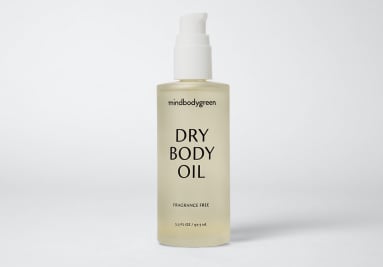
mbg Beauty Director
mbg Beauty Director
Alexandra Engler is the beauty director at mindbodygreen and host of the beauty podcast Clean Beauty School. Previously, she’s held beauty roles at Harper’s Bazaar, Marie Claire, SELF, and Cosmopolitan; her byline has appeared in Esquire, Sports Illustrated, and Allure.com.

Image by g-stockstudio / iStock
March 11, 2023
For those who are serious about wanting supple, glowing skin—it’s time to invest in a good oil. Oils are so spectacular for the skin for a few reasons: First, many types can act as emollients, which means they soften and repair the skin with things like fatty acids, ceramides, and other lipids. But they also have occlusive properties, so they sit on the skin creating a barrier—keeping hydration underneath, and helping shield the skin from environmental stressors. Finally, many botanical oils come loaded with antioxidant powers, which will help ease oxidative stress, protect against dark spots, and smooth texture.
If that all sounds like skin care qualities you’re after, allow me to walk you through some of my favorite oils to look for on ingredient lists.
Advertisement
This ad is displayed using third party content and we do not control its accessibility features.
Safflower seed oil
Most options on the market utilize base oils of some kind (especially if the formula uses essential oils). Base oils are vital to the formula, providing an appealing texture, stability, and often a few skin care benefits themselves. But not all carrier oils are created equal.
One of my personal favorites right now is a safflower seed oil. The lightweight, illuminating oil is extraordinarily high in essential fatty acids, specifically omega-6 fatty acids1 (it constitutes about 70% of the oil makeup). Research shows that omega-6 fatty acids are the most abundant fatty acid in the epidermis (top layer of the skin) and therefore play an integral role in the skin barrier function.2 In addition, research shows that omega-6 fatty acids can help deal with inflammation in multiple layers of the epidermis, which can help prevent signs of premature aging, ease irritation and dryness, and more.
Advertisement
This ad is displayed using third party content and we do not control its accessibility features.
Vitamin E
Moringa seed oil
This fatty acid and antioxidant rich plant oil is one of my favorite options to look for. Moringa seed oil is high in monounsaturated fatty acids, with 70% of that being oleic acid. This specific combination makes it excellent for barrier support, improving water retention, and even easing fine lines.
On the latter point, research suggests that moringa seed oil possesses enhanced antioxidant capabilities6, meaning it can help manage free radical damage in the skin. Free radical damage can lead to fine lines, crepiness, and dark spots—think of it as turning up the dial on the aging process. So whatever you can do turn it back down, is hugely beneficial.
Advertisement
This ad is displayed using third party content and we do not control its accessibility features.
Squalane
This oil has become quite popular over the years, as plant-derived options have become more abundant. Squalene (it’s nonhydrogenated cousin) is naturally produced by the body and actually found in your skin’s sebum! Here, it plays a critical role in keeping skin conditioned and protected. However, squalene production naturally decreases with time.
When applied topically, squalane (notice the “a”; this version is hydrogenated and more shelf stable), can help replenish the skin’s lipids, aid in barrier function, and restore vibrancy.
Oat oil
An absolute star oil for sensitive skin folks, oat oil is the lipid component from the oat plant. (Its more well-known relative, colloidal oatmeal, is derived from the same plant and is actually an FDA-approved skin protectant!)
The oil is full of fatty acids, like omega-6 which we discussed earlier, but what makes it special is its potential role in ceramide production. Research shows that oat oil has been known to boost ceramide levels in the skin7, which help to keep skin cells together. Ceramides are lipids found in the outermost layers of the skin—and fundamental to its barrier function.
In addition, it can also help deal with signs of sensitivity, such soothing itch, reducing inflammation, and helping to reduce redness.
Advertisement
This ad is displayed using third party content and we do not control its accessibility features.


